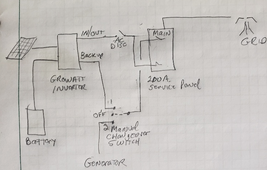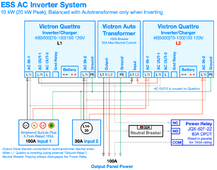Is there anything wrong (i.e. against any code) with feeding the output of a grid tie inverter (Growatt MIN144000TL) back to the main service panel through a "generator" circuit breaker and a manual* transfer switch? The circuit breaker would be interlocked with the main breaker of course. The Growatt backup output is 25 amps, 240V max.. I can't see anything bad happening because the transfer switch would be off, except during a power outage. This would mean I wouldn't have to install a separate critical loads panel (which I would manage manually anyway).
*I don't want automatic transfer because some loads would kill the backup battery, but are still needed occasionally. For example the aerobic septic system. If the power goes out I don't want the septic system aerator to be on 24/7. I want to control it manually to conserve battery life.

*I don't want automatic transfer because some loads would kill the backup battery, but are still needed occasionally. For example the aerobic septic system. If the power goes out I don't want the septic system aerator to be on 24/7. I want to control it manually to conserve battery life.




